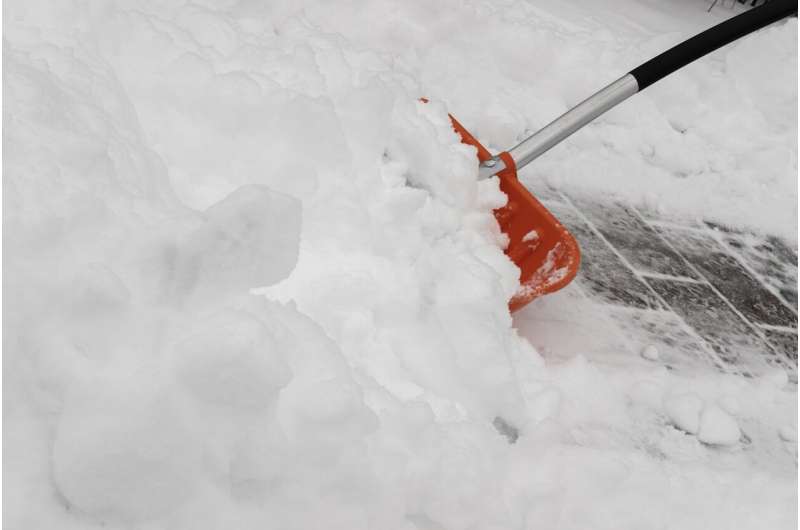This article has been reviewed according to Science X's editorial process and policies. Editors have highlighted the following attributes while ensuring the content's credibility:
fact-checked
reputable news agency
proofread
Q and A: Avoiding shoulder injuries while shoveling snow

Last winter, I slipped and fell shoveling snow. I have arthritis in one of my shoulders. I'm concerned about having another injury. How common are shoulder injuries during the winter due to shoveling snow and other activities? What advice do you have for how to avoid injuring my shoulder?
ANSWER: Unfortunately, the numbers don't lie. In Mayo Clinic's orthopedics practice, the number of people who need care due to shoulder injuries increases substantially during the winter. While wrist fractures, and other hand and arm injuries, are common, too, during the winter, the burden of work that falls on the shoulder increases the risk of injury.
Shoveling snow is one activity that can really strain the shoulder. Lifting and throwing heavy piles of snow, or accidentally hitting hard ice hidden beneath the snow with a shovel, can result in shoulder damage, especially in someone who already has a delicate shoulder. People who have been diagnosed with shoulder arthritis and those who have even a small rotator cuff tear need to take extra care in the snow and ice. Lifting too much snow with a shovel can aggravate the arthritis or further damage the rotator cuff.
In general, before shoveling snow, most people should perform shoulder exercises to stretch and warm up. And if you feel pain building up in your shoulder, consider that a sign that it's time to take a break instead of ignoring the warning. Go inside; get some coffee, tea or hot chocolate; and let your shoulder recover.
If your shoulder is painful—and to reduce risk for injury—you may be better off looking to alternatives, such as hiring a snow removal service, using a snowblower, or, at a minimum, taking your time and shoveling smaller piles of snow one at a time. And, again, be mindful of any increased pain, as that is a sign your body needs attention.
More often, bad shoulder injuries occur in winter because of a fall. Those who live in colder climates know how slippery ice can be. It is so easy to fall with one misstep. And, typically, no one sees it coming. In some cases, a fall on the ice will lead to substantial injuries, including fracture of the collarbone or humerus, dislocation of the shoulder joint, and a shoulder separation. In those circumstances, pain is severe, and most people should choose to go to the emergency department right away.
Fortunately, many people are left with only a bruise that will be painful for a while, but they will have no lasting consequences. However, it is easy to suffer an acute rotator cuff tear. When that happens, it is important to seek prompt medical attention.
Tears of the rotator cuff fall into two major categories: sudden injury and injuries over time due to chronic wear. Most rotator cuff tears are due to chronic wear, and many people respond to physical therapy as far as treatment to regain range of motion.
However, when the rotator cuff tears as a consequence of a sudden injury, surgery is oftentimes necessary and more importantly time-sensitive. Surgical repair of these so-called acute tears can restore normal shoulder function, provided the repair is performed almost right away. However, if an acute tear is missed, and surgical repair is attempted later, the chances of success decrease as the torn tendons retract and stiffen, and the muscle fibers degenerate into fat.
But how would you know if you tore your rotator cuff? Loss of motion is key. If you fall only to realize you cannot move your shoulder when you stand up from the ground, you should be concerned. The following two to seven days will be important in terms of seeking care and treatment. If you cannot lift your arm much, even after a week, it is time to see your primary care professional and be evaluated with radiographs and, most likely, an MRI or ultrasound. If your cuff tendons are found to be torn because of an injury, you should be referred to a shoulder specialist right away.
The best advice for avoiding an injury is to always be cautious when walking outside, use proper footwear, make sure walkways and driveways are clear of ice and snow, use salt on your walkways frequently, and do not walk in a rush.
It is easy to take a fall and injure your shoulder. In the event that you do suffer shoulder pain or an injury, seek out a shoulder specialist who can guide you to the best treatment.
2023 Mayo Clinic News Network.
Distributed by Tribune Content Agency, LLC.



















